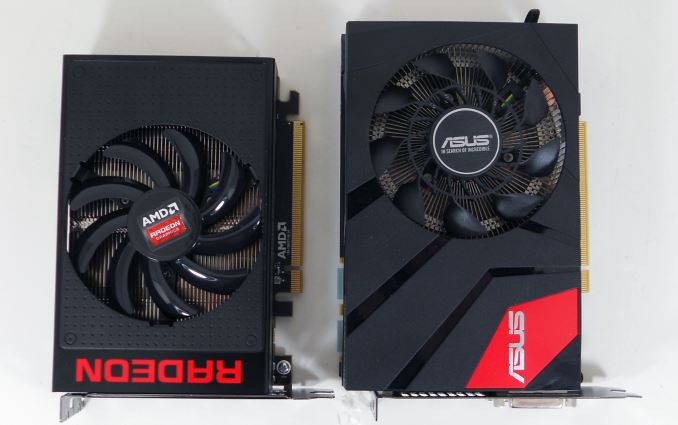The AMD Radeon R9 Nano Review: The Power of Size
by Ryan Smith on September 10, 2015 8:00 AM ESTThe Competition
One of the issues in testing an unusual card like the R9 Nano is figuring out what to test it against. By and large most of the video cards we receive are, well, large, which is suitable for evaluating high performance cards, but presents a bit more of a problem when looking for something to compare the R9 Nano to.
Anticipating this problem, AMD offered to send us a competitive NVIDIA card as well, ASUS’s GeForce GTX 970 DirectCU Mini. As a matter of policy we typically don’t accept rival cards from a vendor in this fashion in order to avoid testing pre-arranged (and contrived) scenarios. However in this case we had already been looking into NVIDIA Mini-ITX cards for this review and had previously settled on trying to get one of the GTX 970 minis, so we opted to break from standard policy and accept the card. As a result we want to be transparent about accepting an NVIDIA card from AMD.

Left: AMD Radeon R9 Nano. Right: ASUS GeForce GTX 970 DirectCU Mini
The Test
Meanwhile after some early experimentation on how to best evaluate the R9 Nano, we have opted to break from tradition a little bit here as well and test the card in two rigs. For our published numbers and for the purposes of apples-to-apples comparisons we are using our standard AnandTech GPU Testbed, a full-tower ATX system.
However in order to also test the R9 Nano in cozier conditions more fitting of its small size, we have also run a limited selection of cards within a second testbed as a control. Unfortunately we don’t have any true Mini-ITX systems around that are suitable for testing the R9 Nano, but for the next best thing we have turned to our frame capture workstation. Based on a Silverstone Sugo SG09 microATX case, this rig is built around a Core i7-3770 and typically houses our frame capture hardware for frame time analysis. For our testing we have pulled this out and set it up with some of our video cards in order to ensure that these cards operate similarly in cramped conditions.

The AnandTech microATX Video Capture Workstation w/R9 Nano
By and large the microATX case simply confirmed our results on our regular testbed after accounting for CPU differences, satisfying that testing in our larger regular testbed wasn’t unfairly impacting any of our major cards. However we’ll revisit the microATX case for our look at power, temperature, and noise.
| CPU: | Intel Core i7-4960X @ 4.2GHz |
| Motherboard: | ASRock Fatal1ty X79 Professional |
| Power Supply: | Corsair AX1200i |
| Hard Disk: | Samsung SSD 840 EVO (750GB) |
| Memory: | G.Skill RipjawZ DDR3-1866 4 x 8GB (9-10-9-26) |
| Case: | NZXT Phantom 630 Windowed Edition |
| Monitor: | Asus PQ321 |
| Video Cards: | AMD Radeon R9 Fury X ASUS STRIX R9 Fury AMD Radeon R9 Nano Club3D R9 390X 8GB royalQueen OC (Underclocked to 1050MHz) AMD Radeon R9 290X AMD Radeon R9 285 AMD Radeon HD 7970 NVIDIA GeForce GTX 980 Ti NVIDIA GeForce GTX 980 ASUS GeForce GTX 970 DirectCU Mini NVIDIA GeForce GTX 780 NVIDIA GeForce GTX 680 NVIDIA GeForce GTX 580 |
| Video Drivers: | NVIDIA Release 355.82 AMD Catalyst Cat 15.201.1102 |
| OS: | Windows 8.1 Pro |










284 Comments
View All Comments
kallogan - Thursday, September 10, 2015 - link
buy an asus directcu gtx 970 mini-itx, oc it a bit, same perf same power consumption for half the price :)Asomething - Thursday, September 10, 2015 - link
and thats only gonna work at 1080p, even funnier is that you think the 970 dcu mini cooler is adequate for an oc, its running at 74c at its boost speed (not an oc). you wont get much more out of it compared to a full sized 970 (you might get another 100-150mhz at best before you start hitting some limits as kitguru found) which wont get you close enough to the nano's performance above 1080p.Peichen - Thursday, September 10, 2015 - link
Any GTX970 can go up to 1450Mhz boosted if not 1500Mhz from 1178Mhz stock boost. That's more than an 20% overclock and as voltage cannot be changed on Nvidia cards, heat will only go up linearly not exponentially.Gigaplex - Thursday, September 10, 2015 - link
The cooler on the mini isn't sufficient to support such a large overclock without sounding like a leaf blower.medi03 - Friday, September 11, 2015 - link
Same perf?Nano is 5% faster than 980, it wipes the floor with 970.
Jeez.
mobutu - Thursday, September 10, 2015 - link
As much as I want AMD to succed in both CPU and GPU fields, I'm afraid this R9 Nano is not good enough.All it takes is a mini980 from nvidia/partners priced at lets say 550 (because of the better cooling solution) and R9 Nano is busted.
Eh, maybe next year with 16-20nm tech and hbm2 ...
HollyDOL - Thursday, September 10, 2015 - link
I'd say it's a case of technology lacking behind architecture. To me Nano seems to simply struggle on generating too much heat for it's capacity to get rid of it... Thus limited frequency and lower performance. It was already visible with water cooled Fury X, but it hurts much more in this small form factor. So for me it's more proof of concept than actually elite class card.T1beriu - Thursday, September 10, 2015 - link
Did you read the review?! It's not about heat. It's about limited power consumption.Gigaplex - Thursday, September 10, 2015 - link
Limited power consumption... to keep the heat output in check. Simple thermodynamics.tipoo - Thursday, September 10, 2015 - link
That rear resistor layout. Nice detail, AMD.http://images.anandtech.com/doci/9621/RearFull.jpg